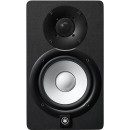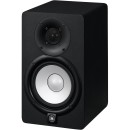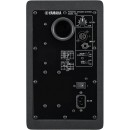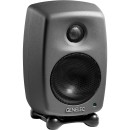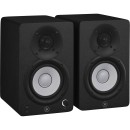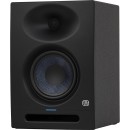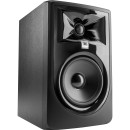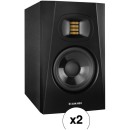Yamaha HS5 Studio Monitor Speaker Review
- 5-inch cone woofer and 1-inch dome tweeter for accurate sound reproduction.
- Bi-amp design with a 45W LF amplifier and a 25W HF amplifier for optimal audio performance.
- Room Control and High Trim response controls for tuning the monitor to your acoustic environment.
- XLR and TRS phone jack inputs for balanced or unbalanced signals.
- Frequency response range of 54Hz to 30kHz for clear and detailed audio.
- Compact design suitable for small studio spaces.
Detailed Specifications, Advantages, and Disadvantages of the Yamaha HS5
The Yamaha HS5 Powered Studio Monitor is a highly acclaimed audio device known for its exceptional sound clarity and precision. Designed for professional and home studio use, the HS5 features a 5-inch cone woofer and a 1-inch dome tweeter, delivering a frequency response that ensures accurate sound reproduction. This makes it an ideal choice for audio mixing and production, where accuracy and detail are crucial.
One of the standout features of the Yamaha HS5 is its bi-amplified design, which provides separate amplifiers for the woofer and tweeter. This results in a cleaner and more efficient signal processing, reducing distortion and enhancing overall sound quality. The monitor also includes room control and high trim response controls, allowing users to optimize performance based on the acoustics of their environment.
With its sleek and minimalist design, the HS5 fits seamlessly into any studio setup. The monitor's robust build quality ensures durability, while its compact size makes it suitable for smaller spaces without compromising on performance. Overall, the Yamaha HS5 Powered Studio Monitor is a reliable choice for anyone seeking professional-grade audio monitoring at an accessible price point.
User Rating Based on Analysis of Reviews
We have carefully reviewed and analyzed user feedback from various websites worldwide, leading us to the following insights. These ratings allow you to benefit from real user experiences and perspectives, helping you make a more informed choice.
Purchase Value
85% of users found the Yamaha HS5 Studio Monitor Speaker to offer excellent purchase value. They appreciated the combination of affordability and performance, which made it an ideal choice for home studios and professional environments alike. Users frequently mentioned that the speaker's accurate sound reproduction and reliable build quality surpassed their expectations for the price point.
15% of users felt that the purchase value of the Yamaha HS5 did not meet their expectations. These users often cited the lack of low-end frequency response as a downside, suggesting that additional equipment, such as a subwoofer, was necessary to achieve a full range of sound, thus increasing the overall cost.
Sound Quality
90% of users praised the Yamaha HS5 for its impressive sound quality, particularly its clarity and precision across mids and highs. They noted that the speaker's flat response was ideal for mixing and mastering, providing an uncolored and accurate representation of audio that allowed for precise adjustments and critical listening.
10% of users were not completely satisfied with the sound quality, primarily due to the insufficient bass response. They reported that the HS5's smaller woofer size limited its ability to accurately reproduce lower frequencies, which could be a drawback for genres that rely heavily on bass.
Build Quality
92% of users were highly satisfied with the build quality of the Yamaha HS5, highlighting its robust construction and durable materials. The speakers' solid design contributed to their reliability, ensuring consistent performance over time, which users found reassuring for long-term use in demanding environments.
8% of users expressed concerns about the build quality, pointing out minor issues such as cosmetic imperfections or occasional manufacturing defects. While these were not widespread, some users felt that such issues detracted from the overall quality they expected from Yamaha.
Ease of Setup
88% of users appreciated the ease of setup that the Yamaha HS5 provided. They found the speaker straightforward to integrate into existing audio setups, with intuitive controls and clear documentation that facilitated a hassle-free installation process.
12% of users encountered difficulties during setup, often related to connecting the speakers to various interfaces or achieving optimal placement in their studio spaces. These users felt that additional guidance or support from Yamaha could improve the setup experience.
Design Aesthetics
86% of users were satisfied with the design aesthetics of the Yamaha HS5. They appreciated the sleek, professional look that complemented their studio environments, noting the understated elegance and modern appeal of the monitors.
14% of users were less impressed with the design aesthetics, with some describing it as too plain or lacking in visual flair. These users felt that a more distinctive design could enhance the speaker's presence in creative spaces.
Frequency Range
83% of users were content with the frequency range offered by the Yamaha HS5, particularly valuing the accurate representation of mids and highs. This made the monitors well-suited for critical listening and professional audio work.
17% of users were dissatisfied with the frequency range, specifically noting the lack of bass extension. For some, this limitation affected the speaker's suitability for producing bass-heavy music without additional equipment.
Size and Portability
80% of users found the size of the Yamaha HS5 to be ideal for small to medium-sized studio setups. They appreciated the balance between compactness and performance, which allowed for flexibility in placement and integration into various environments.
20% of users found the size and portability to be a limitation, particularly if they required more powerful monitors for larger spaces. Some users also mentioned that the weight of the speakers made them less portable than they would have liked.
Volume Output
84% of users were satisfied with the volume output of the Yamaha HS5, noting that they provided ample power for most studio applications without distortion. Users appreciated the clear and consistent output even at higher volumes.
16% of users felt that the volume output was insufficient for their needs, particularly in larger rooms or when compared to higher-end models. They noted a need for additional amplification to achieve desired sound levels.
Input Options
82% of users were satisfied with the available input options on the Yamaha HS5, which included balanced XLR and TRS connections. This allowed for easy integration with various audio interfaces and mixing consoles.
18% of users expressed dissatisfaction with the input options, citing a lack of versatility for those who required additional connectivity features such as RCA or Bluetooth.
User Manual and Documentation
78% of users found the user manual and documentation to be helpful and well-organized. They appreciated the clear instructions and troubleshooting tips provided, which facilitated a smooth setup and operation process.
22% of users found the documentation lacking, particularly in detailed explanations for advanced features or technical specifications. Some users felt that more comprehensive guides could improve the overall user experience.
Durability
91% of users were impressed by the durability of the Yamaha HS5, noting that the speakers maintained their performance and appearance over time, even with frequent use. This reliability contributed to users' confidence in their investment.
9% of users experienced issues with durability, reporting occasional problems with components such as the power switch or connections. These isolated incidents led to concerns about long-term reliability for some users.
Customer Support
75% of users had positive experiences with Yamaha's customer support, finding the team responsive and helpful in resolving issues or providing product guidance. Users appreciated the quick turnaround on queries and effective solutions offered.
25% of users were dissatisfied with customer support, citing slow response times or lack of satisfactory resolutions to their problems. Some users felt that the support experience did not meet the standards set by Yamaha's product quality.
Warranty
77% of users were pleased with the warranty offered by Yamaha, which provided peace of mind and assurance in the case of defects or malfunctions. Users valued the company's commitment to standing behind their products.
23% of users were dissatisfied with the warranty terms, feeling they were too limited in duration or scope. Some users encountered difficulties in making claims or receiving timely replacements, which affected their overall satisfaction.
Versatility
81% of users appreciated the versatility of the Yamaha HS5, noting its suitability for a wide range of audio applications, from music production to casual listening. The speaker's accuracy and reliability made it a valuable tool for various audio tasks.
19% of users felt that the HS5's versatility was limited, particularly in environments requiring more extensive bass reproduction or specific audio characteristics. These users often needed additional equipment to meet their specific audio needs.
Weight
79% of users were satisfied with the weight of the Yamaha HS5, finding it manageable for most studio setups. The solid construction contributed to the speaker's stability without making it overly cumbersome.
21% of users found the weight to be a disadvantage, particularly for those who needed to frequently move or transport the speakers. They suggested that a lighter design could improve portability without sacrificing build quality.
Brand Reputation
93% of users trusted the Yamaha brand and felt confident in their purchase of the HS5 speakers due to the company's longstanding reputation for quality and innovation in audio equipment. This confidence was reflected in their overall satisfaction with the product.
7% of users had concerns regarding the brand reputation, often related to past experiences with other products or perceived inconsistencies in product quality. These users were cautious about fully endorsing the brand based on their experiences.
Compatibility with Accessories
82% of users found the Yamaha HS5 compatible with a range of audio accessories, including stands, isolation pads, and cables. This compatibility enhanced their ability to customize their audio setup to suit their specific needs.
18% of users experienced compatibility issues with certain accessories, particularly those requiring non-standard connections or mounting options. This occasionally limited their ability to achieve their desired setup configurations.
Value for Professional Use
87% of users considered the Yamaha HS5 to offer excellent value for professional use, noting its accurate sound reproduction and reliable performance as key factors in their workflows. These attributes made the HS5 a popular choice among audio professionals.
13% of users felt that the HS5 fell short for professional use, particularly in high-end studio settings where more advanced features or greater power were necessary. These users often opted for more expensive models to meet their needs.
User Reviews and Ratings
89% of users left positive reviews and ratings for the Yamaha HS5, highlighting their satisfaction with the speaker's performance, build quality, and sound fidelity. These reviews frequently commended the HS5's ability to meet a variety of audio needs effectively.
11% of users provided less favorable reviews, typically focusing on specific shortcomings such as limited bass response or minor quality control issues. These reviews reflected specific user expectations that were not fully met by the product.
Overall Satisfaction
88% of users reported overall satisfaction with the Yamaha HS5, citing its reliable performance, excellent sound quality, and value for money as primary reasons for their positive experiences. The speaker's ability to deliver accurate audio reproduction made it a preferred choice for many users.
12% of users were not fully satisfied, often due to specific limitations such as the bass response or setup challenges. While these issues did not overshadow the overall positive reception, they represented areas where users felt improvements could be made.
In the following sections, we will delve into the specifications of the Yamaha HS5 Studio Monitor Speaker, highlighting its unique features. Additionally, we will discuss the advantages and disadvantages of this product to provide a balanced and thorough review.
Pros:
- The Yamaha HS5 delivers a flat frequency response, which is ideal for accurate sound reproduction and mixing.
- It has a robust build quality, ensuring durability and long-lasting use.
- The compact size makes it suitable for smaller studios or workspaces.
- The HS5 includes room control and high trim response controls, allowing for better customization to your acoustic space.
Cons:
- The 5-inch woofer may not provide enough low-end frequency response for those requiring deep bass.
- It lacks built-in Bluetooth or wireless connectivity, which may be a drawback for some users.
- The sweet spot for optimal listening is relatively narrow, requiring careful positioning in the studio.
- Does not include a subwoofer, which might be necessary for complete frequency coverage in some setups.
General
| Number of Included Monitors | Single Monitor |
|---|---|
| Enclosure | Bass-Reflex/Ported |
| Total Power Output | 70 W |
Number of Included Monitors: Single Monitor - This specification indicates that the package includes one studio monitor. This is important for users who need to know how many units they are purchasing, especially if they are setting up a stereo or multi-channel mixing environment. A single monitor is ideal for mono mixing or as an addition to an existing setup.Show More
Enclosure: Bass-Reflex/Ported - The enclosure type refers to the design of the monitor's cabinet. A bass-reflex or ported enclosure is designed to enhance low-frequency performance by allowing air to move in and out of a port. This design generally provides more efficient bass response compared to a sealed enclosure, making it suitable for monitoring bass-heavy music or detailed low-end mixes.
Total Power Output: 70 W - This specification describes the total amount of power the monitor can output, which in this case is 70 watts. Power output is crucial as it determines the loudness and clarity of the sound the monitor can produce. A 70-watt output provides a good balance for nearfield monitoring in a standard studio setting, offering sufficient volume and dynamic range for critical listening and mixing tasks.
Drivers
| Tweeter | 1x 1" / 25.4 mm Dome |
|---|---|
| Woofer | 1x 5" / 12.7 cm Cone |
| Amplifiers | LF: 1 x 45 W Class-D HF: 1 x 25 W Class-D |
Tweeter: The Yamaha HS5 features a 1-inch (25.4 mm) dome tweeter. Tweeters are responsible for producing the higher frequency sounds in the audio spectrum. A dome tweeter design typically offers a wide dispersion of sound, which means that the high frequencies are evenly distributed across the listening area. The size of the tweeter is crucial as it determines its ability to handle high frequencies and produce clear, crisp sounds.Show More
Woofer: This studio monitor is equipped with a 5-inch (12.7 cm) cone woofer. Woofers are designed to handle the lower frequency range, delivering the bass and mid-range sounds. The size of the woofer affects its bass response; a 5-inch woofer is generally well-suited for smaller studio environments, providing a good balance of bass without overwhelming the space.
Amplifiers: The Yamaha HS5 uses Class-D amplifiers, which are known for their efficiency and ability to deliver powerful sound without generating much heat. The amplifier configuration includes a 45-watt amplifier for the low frequencies (LF) and a 25-watt amplifier for the high frequencies (HF). This bi-amplification setup ensures that each driver receives the appropriate amount of power, enhancing the overall sound clarity and accuracy by reducing distortion and providing a balanced audio output.
Performance
| Frequency Range | 74 Hz to 24 kHz (-3 dB) 54 Hz to 30 kHz (-10 dB) |
|---|---|
| Analog Input Sensitivity/Gain | -10 dBu |
Frequency Range: The frequency range of a studio monitor indicates the span of audio frequencies that the speaker can reproduce. For the Yamaha HS5, this range is specified from 74 Hz to 24 kHz at a -3 dB level, and from 54 Hz to 30 kHz at a -10 dB level. The lower end of the spectrum (in Hz) represents the bass frequencies, while the upper end (in kHz) represents the treble frequencies. This range suggests that the HS5 is capable of delivering detailed sound reproduction across a wide spectrum, although it may be less effective in producing very low bass frequencies, which is common for studio monitors of this size. The two different dB levels indicate the points at which the frequency response is slightly attenuated, providing a more nuanced understanding of the monitor's performance across the spectrum.Show More
Analog Input Sensitivity/Gain: This specification refers to the level of input signal that the monitor can handle efficiently. A -10 dBu sensitivity means that the HS5 is designed to work well with consumer-level audio equipment, which typically outputs signals at lower levels compared to professional audio gear. This sensitivity setting ensures that the monitor can receive and amplify a wide range of input signals without distortion, making it versatile for home studios or setups where a mix of consumer and professional audio sources might be used. Proper input sensitivity ensures optimal performance and prevents overloading the input stage of the monitor, which could degrade sound quality.
Signal Processing
| EQ | 1x LF Shelf: -4 to 0 dB at 500 Hz (2 dB Increments) 1x HF Shelf: -2 to +2 dB at 2 kHz (2 dB Increments) |
|---|---|
| Filters | |
| Parametric EQ | |
| Crossover Frequency | 2 kHz |
| Phase Adjustment |
EQ: The Yamaha HS5 features equalization options that include a low-frequency (LF) shelf and a high-frequency (HF) shelf. The LF shelf allows you to adjust the bass frequencies, with a range of -4 to 0 dB at 500 Hz in 2 dB increments. This means you can reduce the bass response if needed to better match your room acoustics or personal preference. The HF shelf lets you adjust the treble frequencies between -2 to +2 dB at 2 kHz, also in 2 dB increments. This flexibility helps in tailoring the speaker's output to suit your listening environment, ensuring a balanced sound.Show More
Filters: The specification indicates that the Yamaha HS5 does not have built-in filters. Filters in audio equipment are used to modify the frequency response by attenuating or boosting certain frequency ranges. The absence of filters suggests that the monitor provides a flat, unaltered output, which is ideal for studio mixing and monitoring purposes as it presents an accurate representation of the sound.
Parametric EQ: The Yamaha HS5 does not include a parametric equalizer. A parametric EQ allows for more precise adjustments to specific frequency bands, including control over the frequency, bandwidth, and gain. The lack of a parametric EQ means that users have less granular control over the frequency response but can still utilize the basic EQ settings to make necessary adjustments.
Crossover Frequency: The crossover frequency of 2 kHz indicates the point at which the audio signal is divided between the monitor's woofer and tweeter. It is the frequency where the low frequencies are handed off to the woofer and the high frequencies to the tweeter, ensuring a smooth transition and balanced sound output across the frequency spectrum.
Phase Adjustment: The absence of phase adjustment means that the Yamaha HS5 does not allow users to modify the phase relationship between different frequency components of the audio signal. Phase adjustment can be important when aligning multiple speakers or correcting phase issues in a particular setup. However, for a single studio monitor like the HS5, this feature may not be as critical.
Connectivity
| Audio I/O | 1x XLR 3-Pin Balanced Input (10 Kilohms) 1x 1/4" TRS Balanced Input (10 Kilohms) |
|---|---|
| Network I/O | |
| USB | |
| Wireless |
Audio I/O: The Yamaha HS5 Powered Studio Monitor is equipped with two types of balanced audio inputs: a 3-pin XLR input and a 1/4" TRS input, both with an impedance of 10 Kilohms. Balanced inputs are essential in professional audio environments because they help reduce noise and interference, ensuring a cleaner audio signal. The 10 Kilohms impedance is standard for line-level inputs, allowing the monitor to be compatible with a wide range of audio equipment. These input options provide flexibility in connecting the monitor to various audio sources, such as audio interfaces, mixers, or other studio equipment.Show More
Network I/O: The Yamaha HS5 does not feature network I/O capabilities. This means it cannot be connected to a network for audio streaming or remote control via a network interface. The lack of network I/O indicates that the monitor is intended for direct, wired connections, which are typically more reliable and preferred in professional studio settings where stable and high-quality audio transmission is critical.
USB: The absence of a USB port on the Yamaha HS5 suggests that it is not designed for direct digital audio input via USB. This feature is sometimes found on monitors that are intended for more consumer-oriented or versatile setups, allowing them to connect directly to computers without an audio interface. The HS5, however, is geared towards professional use, where audio interfaces and other equipment are used to manage digital-to-analog conversion and audio routing.
Wireless: The Yamaha HS5 does not have wireless capabilities. This means that it cannot connect to audio sources via Bluetooth or other wireless technologies. The absence of wireless functionality is typical for studio monitors, as wired connections are preferred for their reliability and superior audio quality, avoiding potential latency and bandwidth issues that can occur with wireless connections.
Power
| AC Input Power | Not Specified by Manufacturer |
|---|---|
| Power Consumption | 45 W |
| Color | Black |
| Enclosure Material | MDF |
| Mounting Points | |
| Dimensions (W x H x D) | 6.7 x 11.2 x 8.7" / 17 x 28.5 x 22.2 cm |
| Weight | 11.7 lb / 5.3 kg |
AC Input Power refers to the electrical power that the monitor requires to operate. In this specification, the exact input power is not specified by the manufacturer, which means that users may need to refer to the product manual or contact the manufacturer for detailed information regarding the power requirements for safe and optimal operation.Show More
Power Consumption is the amount of electrical power the studio monitor uses during operation. At 45 watts, the Yamaha HS5 is energy-efficient, ensuring that it does not consume excessive electricity while still delivering high-quality sound output. This is beneficial for both home studios and professional environments where energy efficiency is a consideration.
Color indicates the external appearance of the studio monitor. This model is available in black, which is a common and versatile choice that can seamlessly fit into various studio aesthetics and professional settings, offering a sleek and unobtrusive look.
Enclosure Material is the type of material used to construct the monitor’s housing, which in this case is MDF (Medium Density Fiberboard). MDF is valued for its acoustic properties, providing a stable and dense structure that helps reduce unwanted vibrations and resonances, thus improving sound clarity and accuracy.
Mounting Points are connection points that would allow the monitor to be mounted on walls or stands. In this specification, there are no mounting points provided, indicating that the monitor is intended to be placed on a flat surface such as a desk or speaker stands and may not be suitable for wall mounting without additional equipment.
Dimensions (W x H x D) specify the physical size of the monitor. With dimensions of 6.7 x 11.2 x 8.7 inches (or 17 x 28.5 x 22.2 cm), the Yamaha HS5 is compact, making it ideal for small to medium-sized studio spaces where space is a constraint. This size allows for easy placement on desks or shelves.
Weight indicates how heavy the monitor is, with the HS5 weighing 11.7 pounds (or 5.3 kg). This weight ensures that the monitor is stable and not easily knocked over while remaining light enough to be moved if needed. It balances portability with functionality, providing a solid feel without being overly cumbersome.
Packaging Info
| Package Weight | 16.2 lb |
|---|---|
| Box Dimensions (LxWxH) | 16.4 x 12 x 10.2" |
Package Weight: The package weight of the Yamaha HS5 Powered Studio Monitor is 16.2 pounds. This specification gives potential buyers an idea of the overall heft of the product when considering shipping or handling. A weight of 16.2 pounds indicates that while the monitor is relatively compact, it has a substantial build, reflecting the quality of materials used in its construction and potentially influencing its stability and vibration absorption when in use.Show More
Box Dimensions (LxWxH): The box dimensions are specified as 16.4 x 12 x 10.2 inches. These measurements provide the size of the packaging in terms of length, width, and height. This is important for understanding the space required for storage or transport and helps users assess whether the box will fit in their intended space for delivery or setup. Compact dimensions suggest ease of handling and storage, making it convenient for users who need to move or install the monitor in various settings.
Customer Images
Customer Questions
How do I connect my Yamaha HS5 to my audio interface?
To connect your Yamaha HS5 to an audio interface, use a balanced TRS or XLR cable. Connect one end to the output of your audio interface and the other end to the corresponding input on the HS5 monitor.
Why is there no sound coming from my Yamaha HS5?
Ensure that the power switch on the HS5 is turned on and that the volume is turned up. Check all cable connections to make sure they are secure. Verify that your audio interface is properly set up and that the correct output is selected in your audio settings.
How do I position my Yamaha HS5 for the best sound quality?
Place the HS5 monitors at ear level and in an equilateral triangle formation with your listening position. Ensure they are at least a foot away from walls to prevent bass buildup and angle them slightly towards your listening position.
What is the correct power voltage for the Yamaha HS5?
The Yamaha HS5 is compatible with 100-240V AC power. Check the voltage specifications in your region and use the appropriate power cable provided with the monitor.
Can I use the Yamaha HS5 for casual music listening?
Yes, the Yamaha HS5 is excellent for casual listening as well as professional audio production. Its flat response provides accurate sound reproduction, allowing you to enjoy music as the artist intended.
How do I adjust the room control and high trim settings on the HS5?
The room control and high trim switches on the back of the HS5 allow you to adjust the sound based on your room's acoustics. Room control can reduce low frequencies, while high trim can boost or cut high frequencies. Experiment with these settings to find the best sound for your space.
What cables do I need for the Yamaha HS5?
You will need balanced TRS or XLR cables to connect the Yamaha HS5 to your audio interface. Ensure the cables are of good quality to maintain sound integrity.
Is one Yamaha HS5 enough for a home studio setup?
While one HS5 can be used for mono sound, a pair is recommended for stereo sound, which is essential for accurate audio mixing and production in a home studio setup.
Why is my Yamaha HS5 emitting a humming noise?
A humming noise often indicates a ground loop issue. Ensure that all your equipment is connected to the same power outlet. You can also try using a ground loop isolator to eliminate the noise.
How do I clean and maintain my Yamaha HS5 monitors?
Use a soft, dry cloth to gently wipe the surface of the HS5. Avoid using any liquid cleaners or sprays directly on the monitor. Regularly check and clean the input connectors to prevent dust buildup, which can affect sound quality.
Comparison
← SWIPE THE TABLE TO SEE MORE →
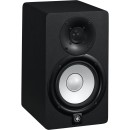
Yamaha HS5 |
VS | |||||
|---|---|---|---|---|---|---|
| Active 2-Way | Monitor Type & Configuration | Active 2-Way | Active 2-Way | Active 2-Way | Active 2-Way | Active 2-Way |
| 70 W | Total Power Output | 50 W | 26 W per Monitor | 80 W | 82 W | 70 W |
| 1x 1" / 25.4 mm Dome | Tweeter | 1x 0.7" / 19 mm Metal Dome | 1x 1" / 25.4 mm Dome | 1x 1" / 25.4 mm Silk Dome | 1x 1" / 25.4 mm Dome | 1x 4" / 102 mm Air Motion Transformer |
| 1x 5" / 12.7 cm Cone |
Woofer |
1x 3" / 7.6 cm Cone |
1x 4.5" / 11.4 cm Cone |
1x 5.25" / 13.34 cm Composite Cone |
1x 5" / 12.7 cm Cone |
1x 5" / 12.7 cm Polypropylene Cone |
| 74 Hz to 24 kHz (-3 dB) 54 Hz to 30 kHz (-10 dB) |
Frequency Range | 67 Hz to 25 kHz (-6 dB) |
83 Hz to 20 kHz (-3 dB) 60 Hz to 22 kHz (-10 dB) |
- | 43 Hz to 24 kHz (-10 dB) | 45 Hz to 25 kHz |
| 1x XLR 3-Pin Balanced Input (10 Kilohms) 1x 1/4" TRS Balanced Input (10 Kilohms) |
Audio I/O | 1x XLR 3-Pin Balanced Input (7 Kilohms) |
2x Combo XLR-1/4" TRS Balanced Mic/Line Input (20 Kilohms) 1x 1/8" / 3.5 mm TRS Unbalanced Line Input (10 Kilohms) 1x Stereo 2RCA Unbalanced Line Input (10 Kilohms) 1x 1/8" / 3.5 mm TRS Speaker Input 1x 1/8" / 3.5 mm TRS Headphone Output 1x Binding Post Pair Speaker Output |
1x RCA Unbalanced Line Input 1x 1/4" TRS Balanced Line Input 1x XLR 3-Pin Balanced Line Input |
1x XLR 3-Pin Balanced Line Input 1x 1/4" TRS Balanced Line Input |
1x XLR 3-Pin Balanced Line Input 1x RCA Unbalanced Line Input |
